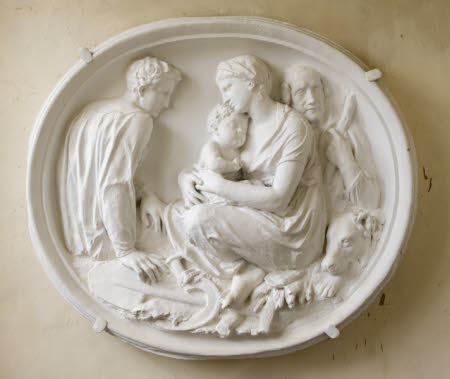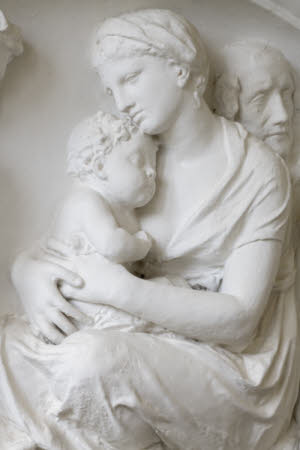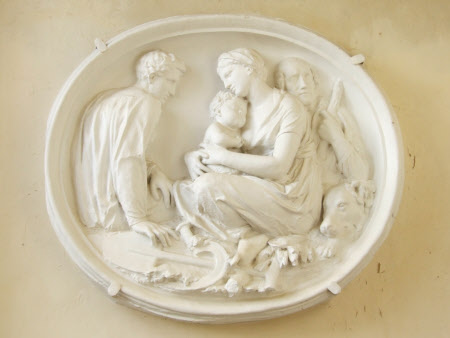Monument to John William Egerton, 7th Earl of Bridgewater (The Holy Family with a Labourer or The Afflicted Peasants)
Sir Richard Westmacott II, RA (London 1775 - London 1856)
Category
Art / Sculpture
Date
1823 - 1825 (exh at RA)
Materials
Painted plaster
Measurements
1130 x 1270 mm
Place of origin
England
Order this imageCollection
Chastleton House, Oxfordshire
NT 1430592
Summary
Plaster relief sculpture (tondo), Monument to John William Egerton, 7th Earl of Bridgewater (The Holy Family with a Labourer or The Afflicted Peasants) by Sir Richard Westmacott RA (London 1775 - London 1856), 1823/25. This is a squeeze or full-scale plaster model taken from - or, just possibly, the repaired and painted-over model for - the central feature of Westmacott's monument to the agricultural improver, John, 7th Earl of Bridgewater (1753-1823), in the church of the parish in which the Bridgewater (and subsequently Brownlow) estate, Ashridge (NT) is situated in St Peter's and St Paul's, Little Gaddesden, Hertfordshire. The peasants are sitting on a shovel, sickle and cut wheat and pause to mourn the daeth of Lord Bridgewater who had constructed the estate of Ashridge Park and was a good enployer. Such overtly religioius imagery could still smack of 'popery' to the Church of England in the early 19th century, which may be why, when Westmacott exhibited what was probably the final marble at the Royal Academy in 1825, it was entitled 'Afflicted Peasants'. It is, however, strongly indebted in spirit to paintings of the Holy Family by Raphael, notably to the tondo from the collection of the 3rd and last Duke of Bridgewater, which the latter had, piquantly, left away from his remote Bridgewater cousin to the future Duke of Sutherland (from whose descendant it is now on loan to the National Gallery of Scotland). This piece came to Chastleton because the sculptor's third son, Horatio, became Rector here, so that he himself was buried in the church yard. Since it was not amongst the plasters (now mostly destroyed) that he presented to the Ashmolean it is perfectly plausible that he should have given or left it to his son, from whom it would have in turn found its way to the Whitmore-Joneses.
Provenance
Probably inherited by the sculptor's third son, Horatio Westmacott, who was Rector of St Mary's Church, Chastleton (where Sir Richard is buried) in 1878;
Makers and roles
Sir Richard Westmacott II, RA (London 1775 - London 1856), sculptor
References
Busco 1994 Marie Busco Sir Richard Westmacott Sculptor. Cambridge Studies in the History of Art, Cambridge University Press, 1994, pp. 165-67, fig. 184


